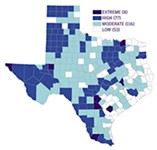The Bigger Picture
Planning comprehensively
By Katherine Gregor, Fri., Jan. 11, 2008

With a quiet Dec. 13 resolution authorizing an update to the city's comprehensive plan – plus a study of fresh long-range planning approaches – City Council has finally taken action to revisit Austin's regional road map for growth and change. Individual neighborhood plans and even the Downtown Austin Plan lack the holistic scope to address big-picture challenges like transit planning. But the 1979 Austin Tomorrow Comprehensive Plan is so egregiously outdated and gnarly with amendments, it's hampering the city's future.
It's no coincidence that council moved to update the comprehensive plan after City Manager Toby Futrell became a lame duck. (The resolution was sponsored by Mike Martinez and co-sponsored by Lee Leffingwell and Will Wynn.) In a transparent May 2006 power play, Futrell killed the recommendations to council made by City Auditor Steve Morgan for a fresh vision and comprehensive planning process. The auditor's recommendations were thoroughly researched (a 10-month audit reviewed peer cities); his report intrepidly asserted the steep cost Austin is paying for its fragmented planning. Futrell's flat-out rejection of practices so basic to good governance appeared ego-driven and political and colored by other conflicts with the auditor. (Futrell: Who needs a community visioning process when we already have a bumper-worthy slogan, "We want Austin to be the most livable city in the country"?) A cowed or indifferent council bowed to Futrell's will.
Yet with all the new urban-planning initiatives now in play (see "Top 10 Developing Stories," Jan. 4), Austin needs a coherent comprehensive plan now more than ever. Last July, the Austin Neighborhoods Council issued a "Call for Action to Manage Austin's Growth" (see www.ancweb.org). It asked council to enact all four of the city auditor's recommendations: "The ANC believes that the lack of well-defined policies and long-term goals which reflect community values undermines the quality of life for the people of Austin and jeopardizes our future." (Former ANC President Laura Morrison is now running for the Place 4 City Council seat currently held by term-limited Mayor Pro Tem Betty Dunkerley.)
A comprehensive plan serves as a way-finding tool: How do we get where we want to go and become the city we most want to be? An adopted plan sets clear policy direction for growth and provides a legal basis for sound decisions on long-term issues. Key components address land use, transportation, economic growth, and environmental protection. Forward-thinking cities regularly revisit and update their comp plans, every five years or so; road maps for managing change must, by definition, respond to evolving conditions.
But for various political reasons, shadowed by intermittent frustrated attempts, Austin has failed to periodically rewrite its comprehensive plan in a comprehensive fashion. Instead, we have layers upon layers of amendments. (For example, every new neighborhood plan is still adopted as an amendment to the 1979 plan.) Lacking a current, cohesive master-plan document, Austinites must consult copious subsequent plans executed by individual city departments, then determine how and whether each overrides the old comprehensive plan. (The city's "Planning for Tomorrow' Web page lists – and links to – some four dozen current city plans and related policy documents.) Senior city planning staff and planning commissioners have told council the voluminously amended comprehensive plan – and thus the intended policy and will of our elected officials – is baffling to interpret. As a result, good policies on the books are not fully applied in many cases. Pity the poor private citizen trying to use the comprehensive plan as a guide for neighborhood issues.
The first step authorized is to simply clean up the mess. According to Martinez aide Andrew Moore, the initiative will gather into one coherent, updated document all of the plans and relevant policies adopted to date. For example, the updated plan will need to incorporate environmental policy – like our latest Water Conservation Plan and the Austin Climate Protection Plan. Then we've got 28 years of adopted plans for how to end homelessness, acquire more parks, make capital improvements, annex suburbs, promote bicycles, prevent smallpox, and save the Armadillo. (Whoops, too late on that one!) Most critical, all departmental plans relevant to land-use, growth management, and development patterns must be melded together.
That's a huge "housekeeping" task. Inevitably, it will entail some subjective interpretations and judgment calls, in cases where individual plans conflict or confuse. (In the 1999 "plain English rewrite" of the Land Development Code, staff made substantive changes – e.g., rewrites to the Waterfront Overlay Ordinance – despite public assurances of only nonsubstantive changes and oversight by a task force.) If all proceeds smoothly, the end product will be a coherent and navigable comprehensive plan document (ideally accompanied by an online search engine) available to the public – and consulted daily by staff, boards and commissions, and City Hall.
The council resolution also directs the city manager and Planning Commission "to study alternative approaches to long-range planning for the greater Austin region." That's an oblique reference to the 2035 Sustainable City Initiative led by Cid Galindo (who recently stepped down from the Planning Commission to run for the same council seat as Morrison). The 2035 concept: With Austin's population projected to grow by 1.6 million by that year (from 900,000 to 2.5 million), long-range planning should carefully direct that urban densification so that it occurs within the existing city limits and jurisdiction (now 402,000 acres). The alternative: Sprawling new greenfield development of 450,000 acres of surrounding open land. Achieving that goal requires agreeing upon targets for absorbing new people gracefully in each urban neighborhood – as Seattle has done. The Comprehensive Planning Committee of the Planning Commission has nudged the idea along since 2006, and it's gaining momentum.
Whether the "interim update" authorized will evolve into a whole fresh comprehensive planning effort remains to be seen. For now, it's good to know the city auditor's recommendations were never really dead, just making like Sleeping Beauty. December's council resolution has delivered the reawakening kiss of political will.
The Long-Term Planning Audit Report is online at www.ci.austin.tx.us/auditor/au05101.htm. The Austin Tomorrow Comprehensive Plan is available at the public library or in a modified version online at www.ci.austin.tx.us/zoning/com_plan.htm.
Got something to say on the subject? Send a letter to the editor.








